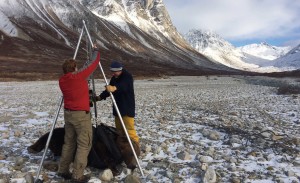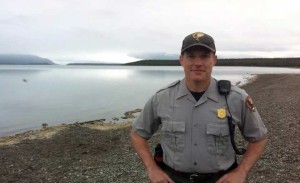Hilderbrand, Pendletons lured to nation’s 49th state
You won’t find Grant Hilderbrand complaining about his commute to work, even if it is 900 miles.

Grant Hilderbrand, left, and helicopter pilot Troy Cambier of Chena River Aviation weigh a brown bear along the upper Kijik River in Lake Clark National Park, Alaska, Oct. 6, 2014. Generally, Hilderbrand gathers specimen data after hibernation ends in the spring. This year he tranquilized 51 bears in 22 days in three parks.
Hilderbrand ’93 is a wildlife biologist in Alaska with the National Park Service. There are 14 National Parks in Alaska covering 55 million acres, which is nearly as big as the entire state of Wisconsin. His home and office are in Anchorage, the 49th state’s most metropolitan city and 600 miles south of the Arctic Circle.
But some of the bears, wolves and salmon he studies are located north of the Arctic Circle while others are 300 miles south of Anchorage at Katmai and scattered elsewhere in this massive state.
So if hibernation is over, there is a good chance Hilderbrand will be out of his cave as well. “It’s hard to be away from home. That’s the big challenge,†said Hilderbrand, who has three children. But being out in the field and observing nature never gets routine, even though he has been at it for 21 years.
The best part of his job is when he is in the field. “I see something every single day that amazes me,†Hilderbrand said.
For example, avalanche-surfing grizzly bears. While catching bears by helicopters at Gates of the Arctic National Park in spring 2014, he noticed a bear jumping up and down atop a cornice on a steep ridge top. Was it an unusual reaction to the invasion of their space? Hilderbrand and his team were stumped.
But then they saw the consequences of that jumping. A chunk of the overhang broke off and the bear flopped on its belly and took nature’s elevator to the main floor.
An epiphany in Alaska
That sight is one of the many things that keeps Hilderbrand in Alaska, a connection that started while studying at Washington State, where the campus was in Pullman but all of the research was in Alaska. He vividly remembers his first trip.
It was spring 1994 and he flew into the Fairbanks airport at 6 a.m. and drove to Denali National Park as the sun was just starting to rise. There he met with other researchers, including Pat Owen, a wildlife biologist with whom he still works. She shot a bear with a tranquilizing dart from a helicopter.
Hilderbrand remained to monitor the bear while the other researchers pursued other bears.
As this 23-year-old young man from the Northern Plains was drawing blood samples and weighing an 800-pound grizzly, “the clouds broke and there was Denali (Mount McKinley)—20,000 feet. I was in the state about three hours and I decided I was going to find a way to live here.â€
He did that by completing his master’s (1995) and his doctorate (1998), then joining the Alaska Department of Fish and Game.
Coming to Divot’s rescue
Then there is the story of Divot the bear, which was a regular at Brooks Camp in Katmai National Park 300 miles southwest of Anchorage. She gained her name because of her habit of digging holes in the sand. Local bear watchers noticed when she disappeared for a couple of weeks last July.
When she reappeared, “something was hanging around her neck.†Closer examination found it to be a wolf snare that had “basically filleted her hide open all the way around her neck,†Hilderbrand said.
Hilderbrand was in Anchorage when he was notified on a Monday afternoon that he would need to help the people at Katmai tranquilize Divot and then remove the snare. He didn’t make it to the park until Tuesday afternoon. It took a couple different flights to reach Brooks Camp, the last being on a float plane. Hilderbrand then stepped off the plane onto a whaler.
“Once I got there, the bear had been in Brooks Camp two days prior, (and) we located her 2 miles to the west at Dumpling Creek,†Hilderbrand said. “There is this thin beach and right at the point there is a little salmon stream.â€
He said the crews from the national park set up in boats floating in Naknek Lake just offshore from Dumpling Creek but the bear kept wandering into the forest. “We saw her one time in about two days but with the boats, we couldn’t get to her and get set up,†Hilderbrand said.
Shooting the bear near water risked drowning, but by Wednesday, given the seriousness of the wound, it was a risk they felt they had to take, he said.
So Hilderbrand darted Divot from the boat. Under the influence of the drug Telazol, which acts as a tranquilizer and analgesic, the bear went down in about two minutes, according to Hilderbrand. The snare was removed, the bear became mobile again in about three hours and was at Brooks Camp the next day.
To see a 40-minute video on the rescue, visit http://youtu.be/n7sbqfgw8VI.
The deeper purpose
Saving Divot is part of a job that can be exhilarating and entertaining, but it has a deeper purpose.
“I remember how important my national park visits were as a child. I want that same thing for my kids and eventually my grandkids.â€
Dave Graves







